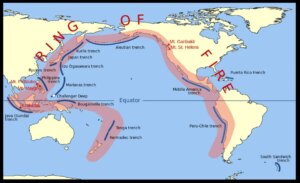
The Pacific Ring of Fire: A Hub of Geological Activity
Understanding Earthquake Clusters: The Pacific Ring of Fire
At Extreme Investor Network, we know that understanding current geological phenomena can have far-reaching implications not just for safety but also for investments in regions affected by seismic activity. Recently, a compelling question was posed: "Mr. Armstrong, when you were in New Zealand, you talked abouthow earthquakes clustered. Is this happening again?"
The answer is a resounding yes. It’s been some time since we’ve observed a notable clustering of seismic events, particularly within the Pacific Ring of Fire—a term that encompasses the series of tectonic plate boundaries that line the Pacific Ocean, making it one of the most geologically active regions on Earth.
What’s Happening in the Ring of Fire?
The Pacific Ring of Fire is infamous for its frequent earthquakes and volcanic eruptions, and current activity indicates that we might be witnessing another cluster of significant seismic events. The geodynamic processes at work imply that movements in one region often create a chain of reaction in others, resulting in pressure building up and leading to larger quakes.
Historically, events of such magnitude have been recorded, and we can anticipate a possibility of a powerful earthquake—perhaps as strong as 9.0—off the coast of Japan soon, with predictions suggesting a higher likelihood between April and July of this year. The science of plate tectonics reveals that when one area of the crust shifts, it can put additional strain on adjacent fault lines, leading to further seismic activity.
A Look Back: Significant Historical Earthquakes
To put the current situation in context, it’s instructive to consider the most powerful earthquakes on record. Here’s a snapshot of the top 20 earthquakes, demonstrating the severity of clustering that can occur:
- Valdivia, Chile (1960) – Magnitude 9.5
- Prince William Sound, Alaska (1964) – Magnitude 9.2
- Sumatra-Andaman Islands (2004) – Magnitude 9.1
- Tōhoku, Japan (2011) – Magnitude 9.1
- Kamchatka Peninsula, Russia (1952) – Magnitude 9.0
- Offshore Maule, Chile (2010) – Magnitude 8.8
- Off the Coast of Ecuador (1906) – Magnitude 8.8
- Rat Islands, Alaska (1965) – Magnitude 8.7
- Assam-Tibet (1950) – Magnitude 8.6
- Northern Sumatra, Indonesia (2005) – Magnitude 8.6
- Unimak Island, Alaska (1946) – Magnitude 8.6
- Banda Sea, Indonesia (1938) – Magnitude 8.5
- Atacama, Chile (1922) – Magnitude 8.5
- Kuril Islands, Russia (1963) – Magnitude 8.5
- South of Sumatra (2007) – Magnitude 8.4
- Sanriku-Oki, Japan (1933) – Magnitude 8.4
- Arequipa, Peru (2001) – Magnitude 8.4
- Near Kamchatka Peninsula (1923) – Magnitude 8.4
- Andreanof Islands, Alaska (1957) – Magnitude 8.6
- Off the West Coast of Northern Sumatra (2012) – Magnitude 8.6
Investing and Preparing for Seismic Phenomena
The implications of increased seismic activity are significant, not only for personal safety but also for economic sustainability in regions like Japan, Chile, and parts of Indonesia that are highly vulnerable to natural disasters. Investors should pay attention to infrastructure developments in these regions and consider the role of geological events in influencing market trends.
In conclusion, staying informed and understanding the dynamics of the Pacific Ring of Fire can empower individuals and businesses alike to make educated decisions, whether it be regarding risk management or opportunities for growth. At Extreme Investor Network, we’re committed to bringing you the insights that matter, helping you navigate the complexities of investing in a world defined by natural forces.
Stay tuned for more insightful discussions and analysis from the Extreme Investor Network as we keep you informed about the changing economic landscapes shaped by geological events.

